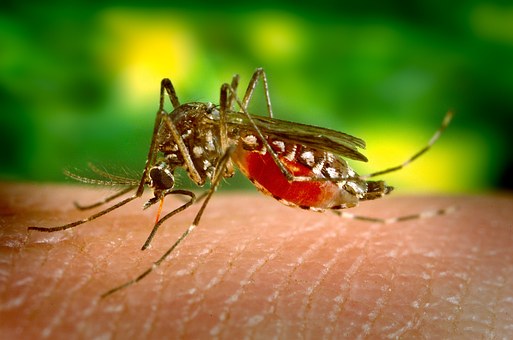See below under documents for the final Permethrin Re-Evaluation documents just released by Health Canada.
It has been brought to our attention by a number of members that the practice of spraying for mosquito control has been started around our Lakes.
Our investigation has brought up a number of serious concerns about this practice. A lot of sprays being used are claimed as being natural but contain the chemical permethrin which is a highly synthesized version of insecticides found naturally in the Chrysanthemum flower. Permethrin is showing to be highly toxic and a threat not only to mosquitos but also to pollinators, birds and aquatic life. The product label specifies application constraints – often a 15 meter barrier is required from the shoreline but wind drift can make that barrier ineffective.
If, where and how pesticides (including permethrin) can be used in Canada is the responsibility of Health Canada’s Pest Management Regulatory Agency (PMRA). Ontario regulates the exterminators that apply it. So this is a multi-jurisdictional and highly technical issue.
In late 2017, PMRA published a proposed “Re-Evaluation Decision of Permethrin” that reviewed the scientific evidence on the health and environmental effects of permethrin and contains several proposed additional restrictions on how permethrin can be used. These were subject to consultation, with the final results expected to be released in 2019, perhaps as early as June. Interested KLCOA members are encouraged to read this document in full (Link at end of article). Following is what that document says in summary form {at page 7} about the environmental impacts of permethrin:
“What Happens When Permethrin Is Introduced into the Environment?
Permethrin is not expected to pose a risk of concern when used according to proposed label directions. Permethrin may pose a risk to aquatic organisms, bees, beneficial insects and birds; therefore, preventative measures to reduce risk to these organisms are proposed.
When proposed label directions are followed, the risks are considered acceptable.
If there is a concern that permethrin is not being applied in accordance with the label directions (frequency, buffer zones, wind conditions, proper signage, etc), please contact the Ontario Spills Hotline (1-800-268-6060) or the Environmental Staff Officer responsible for the Haliburton area (705-927-7809) or both. We have been told that complaints will promptly be investigated.
When permethrin is released into the environment, it can enter soil and surface water where it can persist under certain conditions. In soil, permethrin binds strongly to soil particles, making it unlikely to move downward in the soil and reach groundwater. In aquatic environments, permethrin rapidly moves out of water and into sediment where it can persist. Permethrin is unlikely to persist in air or move in air to remote locations such as the arctic. Permethrin is not likely to accumulate to levels of concern in the tissues of organisms, such as fish.
In terrestrial environments, permethrin can pose a potential risk to bees and other pollinators, as well as beneficial insects and birds if they are exposed to high enough levels of this pesticide. The risk to bees can be reduced by restricting or prohibiting the application of permethrin during the crop blooming period. The risk to beneficial insects living in habitats adjacent to the application site may be reduced by minimizing spray drift. Precautionary label statements are proposed on permethrin product labels to inform users of the potential hazard to bees, beneficial insects and birds and indicate the risk reduction measures that must be followed.
In aquatic environments, water modelling indicates that permethrin may be found at concentrations that pose risks of concern to aquatic invertebrates, fish and amphibians. Canadian water monitoring information confirms that, although rarely detected, permethrin can be found in aquatic environments at concentrations that would be expected to pose risks to aquatic invertebrates, fish and amphibians. Spray buffer zones are therefore proposed to protect aquatic organisms from spray drift. To reduce the risks of permethrin being carried in runoff to aquatic environments, in addition to precautionary label statements, a mandatory requirement for the construction and maintenance of a 10 m vegetative filter strip between the area of application and water bodies is proposed.”
Based on this, and until PMRA’s re-evaluation is finalized, we encourage members who are considering spraying to:
- Make sure to clear up mosquito breeding grounds (areas of standing water and leaf litter) to minimize the population;
- Read PMRA’s document to fully understand the risks;
- Advise their neighbours if they are planning to spray and ensure the required public notice signs are posted;
- Ask to see the product label for the product to be sprayed and ensure that the exterminator will comply with these requirements;
- Do not spray within a buffer zone of at least 10 metres (or whatever distance is specified on the product label – it may be 15 metres or more) from the lake;
- Do not spray during blooming periods;
- Do not spray on plants/flowers/bushes/trees frequented by bees, butterflies and other pollinating birds & insects;
- Do not spray on windy days;
- If you have a cat, understand the potential health impacts of permethrin on cats.
We have collected many documents relating to this topic some of which are below:
Summary of Health Canada Permethrin Re-Evaluation
Full text of Health Canada Permethrin Re-Evaluation
PMRA’s Proposed Re-Evaluation Decision
Beyond Pesticides: Permethrin Facts
Backgrounder from Canadian Physicians for the Environment
Safety Data Sheet on Permethrin
Newspaper Article form the Gravenhurst Banner – Beekeeper Article
Again, if there is a concern that permethrin is not being applied in accordance with the label directions (frequency, buffer zones, wind conditions, proper signage, etc), please contact the Ontario Spills Hotline (1-800-268-6060) or the Environmental Staff Officer responsible for the Haliburton area (705-927-7809) or both. We have been told that complaints will promptly be investigated.

